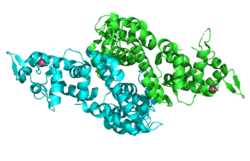Biology:Citrin
| solute carrier family 25, member 13 (citrin) | |
|---|---|
 The protein citrin (PDB 4P5W) is a dimer and is composed of two equal polypeptide chains. | |
| Identifiers | |
| Symbol | SLC25A13 |
| Alt. symbols | CTLN2 |
| NCBI gene | 10165 |
| HGNC | 10983 |
| OMIM | 603859 |
| RefSeq | NM_014251 |
| UniProt | Q9UJS0 |
| Other data | |
| Locus | Chr. 7 q21.3 |
Citrin, also known as solute carrier family 25, member 13 (citrin) or SLC25A13, is a protein which in humans is encoded by the SLC25A13 gene.[1]
Citrin is associated with type II citrullinemia[2][3][4] and neonatal intrahepatic cholestasis caused by citrin deficiency (NICCD).
Function
Citrin (74 kDa) is a dimeric calcium-activated glutamate/aspartate carrier found in the mitochondrial membrane of mammals. Citrin is one of two isoforms of these mitochondrial calcium-activated glutamate/aspartate carriers found in humans and is predominately expressed in non-excitable tissues.[5]
Upon binding calcium, citrin catalyzes the transport of glutamate and a proton into the mitochondrial matrix in exchange for aspartate transport to the cytosol. Upon being transported by citrin from the mitochondrial matrix to the cytosol, aspartate is converted into oxaloacetate, and then into malate, which is then transported back into the matrix by means of the malate-aspartate shuttle. Upon entering the mitochondrial matrix, malate is converted back into oxaloacetate to participate in the citric acid cycle. Citrin is also important because it supplies liver cells with aspartate that is used during the urea cycle and gluconeogenesis. [5]
Structure
The citrin monomer peptide has a three-domain structure, consisting of an N-terminal domain, a carrier domain, and a C-terminal domain. The N-terminal domain contains eight EF-hand motifs and is responsible for the binding of a single calcium ion. The N-terminal domain is also responsible for the dimerization of the protein to form the full glutamate/aspartate carrier. The carrier domain is responsible for transport activity and consists of six helical loops that link the N-terminal and C-terminal domains together. The C-terminal domain’s function is not fully understood yet, but it is thought to be an extra helix for the carrier domain to help account for its hydrophobicity.[5]
Upon the binding of two calcium ions to the citrin dimer’s N-terminal domains, a structural change causes an amphipathic helix within the C-terminal domain to bind to a hydrophobic loop within the N-terminal domain, causing an opening. This opening gives the substrates such as glutamate and aspartate access to the inner carrier domain which transports them across the membrane. Upon the unbinding of calcium, the first and second EF motifs within the N-terminal domain block off and close the opening, preventing the passage of substrates.[5]
Diseases
Type II citrullinemia is a liver disease caused by mutations in the SLC25A13 gene, which codes for the citrin protein. Most of these mutations lead to an unfunctional citrin protein, meaning it cannot work to properly transport aspartate from the mitochondria to the cytosol. Aspartate plays a vital role in the urea cycle by reacting with citrulline to form argininosuccinate. Without adequate amounts of aspartate in the cytosol, this intermediate step in the urea cycle cannot happen, leading to an increase in the concentration of citrulline, ammonia, and other toxins since they can no longer be converted to urea by the liver.
See also
References
- ↑ "The gene mutated in adult-onset type II citrullinaemia encodes a putative mitochondrial carrier protein". Nature Genetics 22 (2): 159–63. June 1999. doi:10.1038/9667. PMID 10369257.
- ↑ "Mitochondrial aspartate glutamate carrier (citrin) deficiency as the cause of adult-onset type II citrullinemia (CTLN2) and idiopathic neonatal hepatitis (NICCD)". J. Hum. Genet. 47 (7): 333–41. 2002. doi:10.1007/s100380200046. PMID 12111366.
- ↑ "Pathogenesis and pathophysiology of citrin (a mitochondrial aspartate glutamate carrier) deficiency". Metab Brain Dis 17 (4): 335–46. 2002. doi:10.1023/A:1021961919148. PMID 12602510.
- ↑ "Adult-onset type II citrullinemia and idiopathic neonatal hepatitis caused by citrin deficiency: involvement of the aspartate glutamate carrier for urea synthesis and maintenance of the urea cycle". Mol. Genet. Metab.. 81 Suppl 1: S20–6. 2004. doi:10.1016/j.ymgme.2004.01.006. PMID 15050970.
- ↑ 5.0 5.1 5.2 5.3 "Calcium-induced conformational changes of the regulatory domain of human mitochondrial aspartate/glutamate carriers". Nat Commun 5 (5491): 5491. 2014. doi:10.1038/ncomms6491. PMID 25410934.
External links
- citrin at the US National Library of Medicine Medical Subject Headings (MeSH)
- GeneReviews/NCBI/NIH/UW entry on Citrin Deficiency
- SLC25A13 human gene location in the UCSC Genome Browser.
- SLC25A13 human gene details in the UCSC Genome Browser.
- Citrin Foundation non-profit funding research to cure citrin deficiency.
- Citrin Foundation patient website website with resources for citrin deficiency patients and families.
 |


